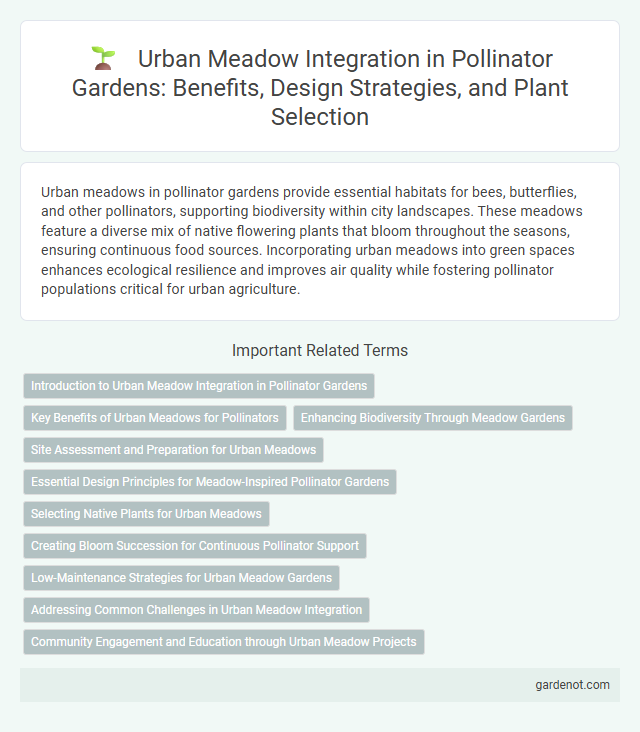Urban meadows in pollinator gardens provide essential habitats for bees, butterflies, and other pollinators, supporting biodiversity within city landscapes. These meadows feature a diverse mix of native flowering plants that bloom throughout the seasons, ensuring continuous food sources. Incorporating urban meadows into green spaces enhances ecological resilience and improves air quality while fostering pollinator populations critical for urban agriculture.
Introduction to Urban Meadow Integration in Pollinator Gardens
Urban meadows enhance pollinator gardens by providing diverse native wildflowers and grasses that support a wide range of pollinators, including bees, butterflies, and hummingbirds. Integrating urban meadows helps increase habitat connectivity and promotes biodiversity in city environments. This sustainable planting strategy also improves soil health and reduces maintenance requirements, making it ideal for urban green spaces focused on ecological balance.
Key Benefits of Urban Meadows for Pollinators
Urban meadows create diverse habitats supporting native pollinator species such as bees, butterflies, and hummingbirds by providing abundant nectar and pollen sources throughout the growing season. These meadows improve urban biodiversity, enhance soil health, and increase resilience to climate fluctuations by promoting native plant growth and reducing pesticide use. Implementing urban meadows contributes to cleaner air and natural pest control, fostering a balanced ecosystem critical for sustainable pollinator populations.
Enhancing Biodiversity Through Meadow Gardens
Urban meadow gardens significantly boost biodiversity by providing diverse habitats that support a wide range of pollinators, including bees, butterflies, and native insects. These meadow gardens feature a mix of native wildflowers and grasses, promoting ecological balance and improving soil health. Incorporating urban meadows into city landscapes creates essential foraging and nesting sites, fostering resilient urban ecosystems and enhancing overall biodiversity.
Site Assessment and Preparation for Urban Meadows
Conducting a thorough site assessment for urban meadows involves analyzing soil composition, sunlight exposure, and existing vegetation to ensure optimal conditions for pollinator habitats. Preparing the site includes removing invasive species, amending soil with organic matter, and creating diverse microhabitats to support a variety of pollinators. Effective planning integrates native wildflowers and grasses adapted to urban environments, promoting biodiversity and resilience in the meadow ecosystem.
Essential Design Principles for Meadow-Inspired Pollinator Gardens
Urban meadows for pollinator gardens prioritize native plant diversity, seasonal bloom succession, and structural complexity to support a range of pollinators year-round. Soil health and sun exposure are critical factors, with mounded terrain and open, sunny locations enhancing plant vigor and pollinator activity. Incorporating layers of ground cover, mid-height plants, and tall flowering species optimizes habitat variety and foraging opportunities.
Selecting Native Plants for Urban Meadows
Selecting native plants for urban meadows enhances biodiversity by providing essential habitats and food sources for local pollinators such as bees, butterflies, and hummingbirds. Native species are adapted to local soil, climate, and water conditions, promoting sustainability and reducing maintenance requirements in urban environments. Incorporating a diverse mix of native wildflowers, grasses, and shrubs ensures continuous bloom cycles that support pollinators throughout the growing season.
Creating Bloom Succession for Continuous Pollinator Support
Establishing an urban meadow with diverse plant species ensures bloom succession, providing continuous nectar and pollen sources for pollinators throughout the growing season. Selecting native wildflowers, grasses, and shrubs with staggered flowering times supports bees, butterflies, and other pollinating insects by maintaining habitat stability and food availability. Strategic planting enhances urban biodiversity and strengthens pollinator populations critical for ecosystem health and food production.
Low-Maintenance Strategies for Urban Meadow Gardens
Urban meadows in pollinator gardens thrive using low-maintenance strategies such as planting native wildflowers and grasses that adapt naturally to local soil and climate conditions. Incorporating drought-tolerant species reduces watering needs, while allowing seasonal growth cycles promotes biodiversity without intensive upkeep. Selecting diverse plant varieties supports pollinators year-round and minimizes the necessity for fertilizers and pesticides, ensuring sustainable garden management.
Addressing Common Challenges in Urban Meadow Integration
Urban meadow integration in pollinator gardens addresses common challenges such as soil compaction, limited sunlight, and invasive species management by selecting native, drought-resistant plants that thrive in urban environments. Incorporating layered vegetation structures enhances habitat diversity and improves pollinator visitation rates, supporting species like bees, butterflies, and hummingbirds. Effective maintenance practices, including seasonal mowing and controlled irrigation, sustain ecosystem health and promote long-term urban biodiversity.
Community Engagement and Education through Urban Meadow Projects
Urban meadow projects foster community engagement by transforming vacant city spaces into vibrant pollinator habitats that serve as living classrooms. These initiatives promote environmental education by involving local residents in planting native wildflowers and monitoring pollinator activity, enhancing ecological awareness. By linking urban biodiversity with hands-on learning, urban meadows strengthen neighborhood connections and support pollinator conservation efforts.
Urban meadow Infographic

 gardenot.com
gardenot.com